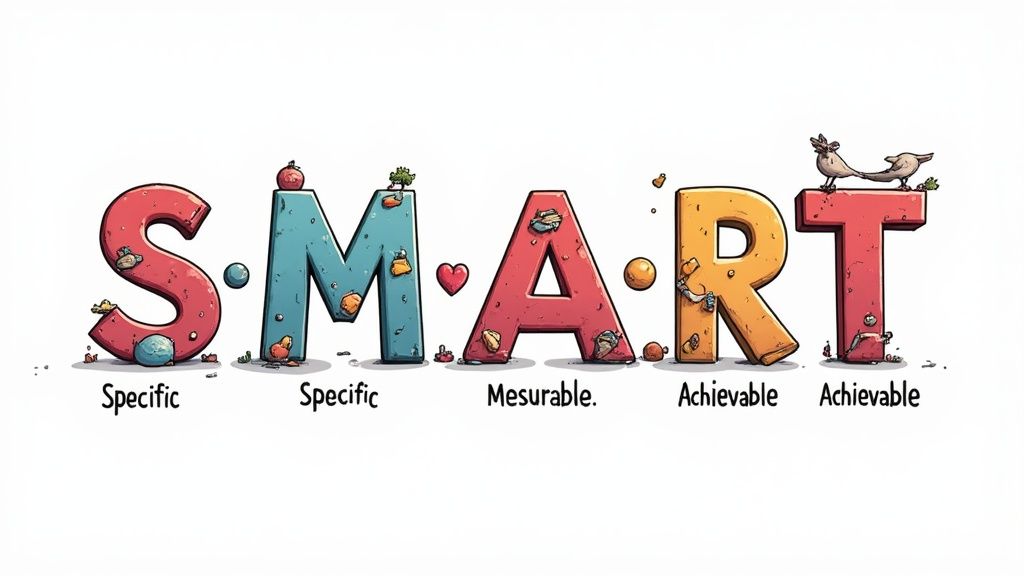Effective Steps for Goal Setting That Actually Work

If you’ve ever felt like your big goals are just wishful thinking, you’re not alone. The real secret to turning those ambitions into reality isn't about having more willpower; it's about having a better system. It's what separates daydreaming from actual, tangible achievements.
This is where we move past simple to-do lists and start building a real strategy.
Building Your Goal-Setting Foundation

Effective goal setting isn't about luck—it's a methodology. It's a structured system that transforms your broad ambitions into a clear, daily process. Think of it as the foundation you build your success on.
Throughout this guide, we'll lean on a powerful tool, Obsibrain, to show you how to centralize your ideas, track your progress, and connect your high-level goals directly to what you do every day. Having a solid system like this is often the only difference between dreaming and doing.
The Power of Frequent Goals
Momentum is everything. Setting small, manageable goals consistently is what creates it. A student aiming for a top grade might use Obsibrain to set a daily goal of "review class notes for 30 minutes," while a freelancer could set a weekly goal to "send out 5 new proposals." This consistency is key.
Don't just take my word for it. Research from PwC found that people who set at least four daily goals per week were 34% more likely to hit their Key Performance Indicator (KPI) targets. This just goes to show how powerful breaking down big objectives into smaller, more frequent actions can be.
A well-built goal-setting system acts as your personal roadmap, guiding you from where you are to where you want to be. It provides clarity when you feel lost and structure when you feel overwhelmed.
Before we dive into the nitty-gritty of setting up your own system in Obsibrain, let's break down the essential pillars that make any goal-setting framework successful. Understanding these components is key to making sure your goals are both ambitious and, more importantly, attainable.
Here’s a quick overview of what we'll be covering.
Core Components of an Effective Goal System
Clarity & Specificity
Vague desires are impossible to measure. You need well-defined outcomes.
Use Smart Projects to define clear, measurable goals.
Actionable Steps
Big goals need to be broken down into small, manageable daily or weekly tasks.
Create and link tasks directly to your projects and goals.
Regular Review
Goals aren't static. Periodic check-ins help you adapt, celebrate wins, and adjust course.
Set up Periodic Notes and review dashboards to stay on track.
These pillars work together to form a robust framework. A great first step in this process is to get your initial thoughts down on paper. Using a personal development plan template can serve as a fantastic blueprint for formalizing your aspirations before you start breaking them down into tactical steps within a tool like Obsibrain.
Defining Clear Goals with the SMART Framework

We've all been there. We set a goal like "get healthier" or "be more productive," and it feels great for a day. But these goals are traps. They're fuzzy, impossible to act on, and ultimately lead to frustration because they lack any real clarity. This is exactly where the SMART framework comes in, turning those vague wishes into concrete objectives you can actually achieve.
Think of it as the structure that turns a dream into a plan. Instead of just saying what you want, it forces you to nail down the critical details. You'll define exactly what success looks like and, more importantly, how you'll get there.
Breaking Down the SMART Criteria
Let's cut through the jargon and get practical. Each letter in SMART is a filter that sharpens your focus, making your goal undeniably clear.
Specific: What exactly do you want to do? "Run a 10k" is infinitely better than "get fit."
Measurable: How will you know you've done it? "Run a 10k in under 60 minutes" gives you a clear benchmark to hit.
Achievable: Is this realistic for you right now? A 10k is a solid goal for a beginner. A full marathon in two weeks? Probably not.
Relevant: Why does this matter to you? Your goal has to line up with your bigger picture to keep you motivated when things get tough.
Time-bound: When will you do it by? "Run a 10k in under 60 minutes by October 1st" creates a healthy sense of urgency.
This simple process is one of the most important steps in effective goal setting. It transforms a loose ambition into a real, trackable target.
A well-defined goal is like a GPS coordinate for your ambition. It tells you exactly where you're going, eliminating the guesswork and aimless wandering that so often leads to failure.
Putting SMART Goals into Action with Obsibrain
Now, let's make this tangible inside Obsidian. With a tool like Obsibrain, you can create a dedicated note for each goal and use custom properties to embed the SMART criteria right into your workflow. This keeps every objective properly structured and easy to track.
For instance, a content creator aiming to grow their YouTube channel could set up a Smart Project in Obsibrain like this:
Goal Name
Grow YouTube Channel to 1,000 Subscribers
Specific
Publish 8 high-quality videos (2 per week).
Measurable
Gain 1,000 new subscribers and 4,000 watch hours.
Achievable
I can allocate 10 hours per week for scripting, filming, and editing.
Relevant
This supports my goal of building an online business.
Time-bound
Achieve this by the end of the current quarter.
When you build your goals this way inside Obsibrain, you’re creating a central dashboard for all your ambitions. Every component is defined, making it simple to see what you need to do next and measure just how far you’ve come.
Deconstructing Your Ambitions into Daily Actions
A huge, year-long goal can feel like staring up at an impossibly tall mountain. The trick to actually climbing it? Stop looking at the summit and start focusing on the very next step in front of you. This is all about deconstruction: breaking down those grand ambitions into quarterly milestones, then monthly targets, and finally, into simple daily tasks.
Think about a goal like, "Launch a successful podcast." That sounds massive. But when you break it down, it suddenly becomes a clear series of actions: research ten competing shows, buy a microphone, record the first three episodes. Each of those is a small, achievable win that builds momentum.
This is where having a structured system really pays off. It helps you turn a fuzzy dream into a concrete roadmap. The infographic below shows this flow perfectly.

As you can see, every big goal is really just a collection of smaller tasks with deadlines. If you're looking for practical tools to get started, exploring some of the top goal planning templates can give you a pre-built structure to follow.
Creating a Project Hierarchy in Obsibrain
This is where a tool like Obsibrain truly shines. You can build a visual hierarchy that directly connects your big-picture goal to the tiny actions you need to take each day. For a developer working on a new app, the "App Launch v1.0" would be the main project note in Obsibrain.
From there, you can use nested checklists or link to other notes to build out the entire structure:
Q1 Milestone: Core Feature Development
Monthly Target (Jan): User Authentication
Daily Task: Design the database schema for users.
Daily Task: Implement the login API endpoint.
Monthly Target (Feb): Main Dashboard UI
Daily Task: Wireframe the dashboard layout.
A goal without a plan is just a wish. Deconstructing your ambition into a hierarchy of actionable tasks provides the concrete plan you need to make consistent, meaningful progress.
This method isn't just for personal goals; it's incredibly powerful for teams, too. Yet, many companies fail to connect individual work to the company's main objectives. Shockingly, while 83% of companies set individual goals, only 56% bother to set them at the department level, leaving a huge gap where team contributions get lost.
When you use a shared system like Obsibrain, everyone on the team can see exactly how their daily to-dos contribute to the bigger picture.
If you want to master this in your own vault, check out our guide on Obsibrain's powerful task management features. It shows you exactly how to build these connected hierarchies from the ground up.
Creating a System for Review and Adaptation

So you've set some ambitious goals. That's the first step, but it's far from the last. The single most common reason goals fall apart is the "set it and forget it" mindset. Life is unpredictable, and your plans need to be just as flexible to keep up.
This isn’t about judging your performance; it’s about building a rhythm of checking in. This simple habit keeps you connected to your original motivation and lets you adjust your path with confidence, not guilt. A consistent review turns a static goal into a living, breathing part of your routine.
A Practical Cadence for Check-Ins
To really build momentum, you need a few different levels of review. Each one serves a different purpose, from quick daily tweaks to major strategic shifts.
Daily Progress Log: This is your quick, two-minute check-in at the end of the day. Did you do what you set out to do? What’s one small win? It keeps your goals right where they need to be—top of mind.
Weekly Focused Review: Block out 30 minutes every week. This is where you look at the bigger picture. Are you on track with your monthly targets? What got in your way, and how can you navigate around it next week?
Monthly Strategic Assessment: Now we’re talking high-level. Look at your main goals and see how you’re tracking against your bigger quarterly milestones. Is the goal still the right one? Does the deadline or strategy need an update?
This structured approach is surprisingly rare. While studies show 51% of companies try to set aligned goals, a startlingly low 6% actually circle back to adjust them. That's a huge gap in a critical part of the process.
Your review system isn’t a test you pass or fail. It’s a feedback loop designed to make you smarter, more agile, and better equipped to handle whatever comes your way.
Building Your Review System in Obsibrain
Obsibrain makes it incredibly simple to bake this process right into your workflow. You can build out dedicated templates for each check-in and link them directly to your main goals for a seamless experience.
For example, a writer with a goal to finish their novel manuscript can use Obsibrain’s Periodic Notes. Their Daily Note template might prompt them to log their word count. Their Weekly Review template could ask, "Did I meet my weekly chapter goal?" and "What plot points need more development next week?". Finally, their Monthly Review can assess overall progress toward the final draft deadline.
This creates an interconnected system where your daily actions and weekly reflections directly feed into your long-term strategy. To see exactly how to get this up and running, check out how to set up Obsibrain's powerful periodic reviews for yourself.
Staying the Course and Pushing Through Roadblocks
Coming up with a goal is the easy part. The real test comes weeks or months later when that initial fire starts to dim and the day-to-day grind sets in. Let's be honest, the path to any worthwhile goal isn't a straight shot; it's full of detours, setbacks, and days where you'd rather do anything else.
That's why building resilience into your goal-setting process from the very start is non-negotiable. You have to anticipate the tough days and have a plan for them. When your motivation takes a nosedive, the first thing to do is reconnect with your "why." What was the deep-seated reason you set this goal in the first place? Remind yourself of that feeling.
Fueling Your Drive with Small Wins
Celebrating progress, no matter how small, is a massive psychological advantage. When you track and acknowledge these little victories, you create a powerful feedback loop that builds momentum for the long haul. This is where your Obsibrain setup becomes your secret weapon.
Imagine a user trying to learn a new language. Inside their "Learn Spanish" project in Obsibrain, they can have a checklist of daily tasks like "Complete one Duolingo lesson" or "Practice 10 new vocabulary words." When they check these off, they not only see the task disappear but also see the project's progress bar inch forward. That visual feedback is a powerful small win that reinforces their daily habit. For students, mastering effective study habits is another fantastic way to build this kind of sustainable momentum toward academic goals.
The secret is remembering that achieving a big goal isn't a single event. It's a continuous cycle of planning, doing, reviewing, and adjusting. Every small win is just proof that your system is working and you're on the right track.
Inside Obsibrain, you can easily create a "Wins" log right inside your project note. At the end of each week, just add a quick bullet point for something you're proud of. It can be as simple as this:
Week 1: Finally had a 5-minute conversation in Spanish, even if it was clumsy!
Week 2: Understood most of a short podcast episode without subtitles.
This simple habit keeps your achievements front and center, giving you a tangible source of encouragement when you hit a wall. It transforms what could feel like a slog into a journey filled with rewarding milestones.
Your Goal Setting Questions Answered
As you start putting these goal-setting steps into practice, questions are bound to pop up. It happens to everyone. Let's tackle some of the most common ones I hear, so you can keep your momentum and navigate the process with confidence.
How Often Should I Review My Goals?
There’s no magic, one-size-fits-all schedule here. The real key is building a rhythm that works for you. Consistency is far more important than sticking to a rigid calendar.
A good starting point is a quick daily check-in to keep your goals top-of-mind. Then, a deeper weekly review for your short-term objectives and a more strategic monthly sit-down for your big-picture ambitions. You can automate this in Obsibrain by setting up Daily, Weekly, and Monthly Note templates, each with specific review prompts to ensure you never miss a check-in.
What If I Don't Meet a Goal?
First off, let's reframe this. Missing a goal isn't a failure—it's incredibly valuable data. It’s a chance to look at what happened, judgment-free, and learn from it.
An unmet goal is simply feedback in disguise. It reveals a weak point in the plan, not a weakness in you. Use that insight to build a stronger strategy for next time.
Was the deadline a bit too ambitious? Did the goal turn out to be less important than you first thought? Maybe a key resource didn't come through. In Obsibrain, you can simply change the status of your project from "In Progress" to "On Hold" or "Revised" and add a note explaining why. This captures the learning without deleting the goal, allowing you to re-evaluate it later. For a deeper dive on this, our full FAQ documentation has some extra insights.
Can I Pursue Multiple Goals at Once?
You absolutely can, but you need a solid strategy. Just trying to chase everything at once is the fastest way I know to get burnt out and make zero meaningful progress.
A much better approach is to prioritize 1-3 primary goals at any given time. A system like Obsibrain makes this easy because you can create different "Areas" like 'Career,' 'Health,' and 'Personal Projects.' By assigning each of your goals to an Area, you can easily filter your dashboard to focus only on health-related tasks for one hour, then switch your view to career goals later. This organized approach prevents overwhelm and ensures you’re moving the needle where it matters most.
Ready to stop switching between apps and start making real progress? Obsibrain is the all-in-one system for Obsidian that turns your ambitions into achievements. Get your lifetime license and start building your best workflow today at https://www.obsibrain.com/en.
Last updated
Was this helpful?